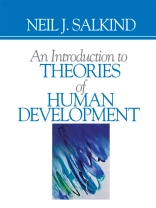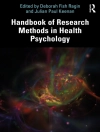‘The book is well written and the theorists and their respective work are well-presented and clearly explained. . . . As a text dealing with the historical overview of major theorists and their work in human development over the last century or so, it is extremely strong and could be widely used in a variety of both undergraduate and graduate courses.’
—Ann C. Diver-Stamnes,
Humboldt State University
‘In general, I found the websites and references listed at the end of each chapter to be very interesting and useful for taking students beyond what is in the text.’ —Jane Ledingham, University of Ottawa
‘A fine choice for a classic theories course, and I believe that the level of presentation would be appropriate for advanced undergraduate or graduate students. . . . The up-to-date web sites at the end of each section are a definite plus. The choice of sites is excellent.’
—Cosby Steele Rogers,
Virginia Tech
An Introduction to Theories of Human Development examines the development process, looking at the series of changes that occur as a result of an interaction between biological and environmental factors. Why might our behavior as an adult be so different from when we were infants? Why and how does one stage of development follow the next? Are the changes that we experience abrupt in nature or smooth and predictable? Author Neil J. Salkind reflects on such critical questions to help readers understand what happens along the way as one develops from infancy through later life.
This book provides a comprehensive view of the primary theoretical models of human development including those from the biological, psychoanalytic, behavioral, and cognitive developmental perspectives. Along with a brief discussion of a historical background for each of these approaches,
An Introduction to Theories of Human Development examines the application of these theories to various aspects of human development, such as the effectiveness of early intervention, individual differences, adolescence, and sociobiology.
Features of this text:
- A final, integrative chapter compares the various theories presented in the book using Murry Sidman′s model of six criteria for judging a theory to help develop students′ skills for critically assessing theory.
- Classic approaches to understanding human behavior across the lifespan are also examined.
- Pedagogical features such as chapter opening quotes, boxed highlights, key terms, a glossary, and websites for further reading enhance student understanding of everyday human behavior.
An Introduction to Theories of Human Development is an accessible text for advanced undergraduate students in the social and behavioral sciences including such fields as psychology, education, human services, nursing, sociology, social welfare, and human development and family studies.
Tabella dei contenuti
PART ONE. AN INTRODUCTION & IMPORTANT IDEAS
1. An Introduction to the Study of Human Development
2. Trends & Issues in Human Development
PART TWO. THE MATURATIONAL & BIOLOGICAL APPROACHES
Arnold Gesell and the Maturational Model
4. The Importance of Biology: Sociobiology & Ethology
PART THREE. THE PSYCHODYNAMIC APPROACH
5. Sigmund Freud′s Psychosexual Theory
6. Erik Erikson′s Focus on Psychosocial Development
PART FOUR. THE BEHAVIORAL PERSPECTIVE
7. The Behavioral Models of Development
8. Social Learning Theory
PART FIVE. THE COGNITIVE DEVELOPMENTAL VIEW
9. Jean Piaget′s Cognitive Model
10. Lev Vygotsky′s Sociocultural Theory of Development
PART SIX. A COMPARATIVE ANALYSIS
11. Comparing Theories of Human Development
Circa l’autore
Neil J. Salkind received his Ph D in human development from the University of Maryland, and after teaching for 35 years at the University of Kansas, he was Professor Emeritus in the Department of Psychology and Research in Education, where he collaborated with colleagues and work with students. His early interests were in the area of children’s cognitive development, and after research in the areas of cognitive style and (what was then known as) hyperactivity, he was a postdoctoral fellow at the University of North Carolina’s Bush Center for Child and Family Policy. His work then changed direction to focus on child and family policy, specifically the impact of alternative forms of public support on various child and family outcomes. He delivered more than 150 professional papers and presentations; written more than 100 trade and textbooks; and is the author of Statistics for People Who (Think They) Hate Statistics (SAGE), Theories of Human Development (SAGE), and Exploring Research (Prentice Hall). He has edited several encyclopedias, including the Encyclopedia of Human Development, the Encyclopedia of Measurement and Statistics, and the Encyclopedia of Research Design. He was editor of Child Development Abstracts and Bibliography for 13 years. He lived in Lawrence, Kansas, where he liked to read, swim with the River City Sharks, work as the proprietor and sole employee of big boy press, bake brownies (see www.statisticsforpeople.com for the recipe), and poke around old Volvos and old houses.












